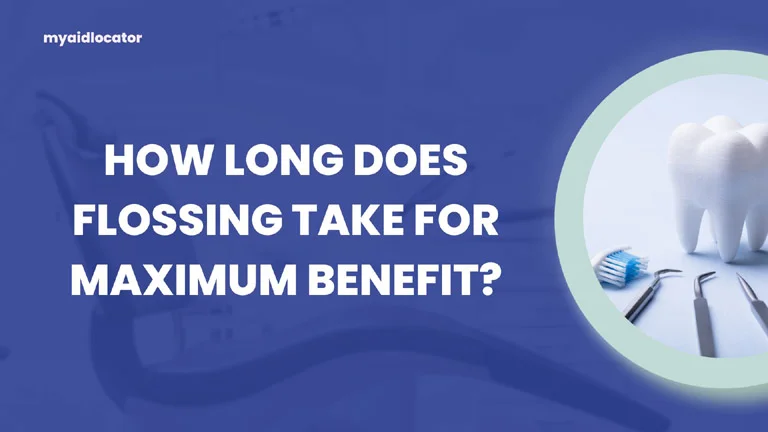How long does flossing take? On average, it will take about 1 to 3 minutes to floss your teeth thoroughly. The time it takes to floss can vary depending on factors such as age, sex and whether you’re using traditional floss, floss picks, or another flossing tool.
Flossing is the process of using a thin, flexible piece of string naturally made of nylon or Teflon to clean between the teeth and remove debris and plaque. This practice targets areas that a toothbrush might miss such as the tight spaces between teeth and along the gumline.
Benefits of Flossing
Flossing removes plaque and bacteria between the teeth so it cannot cause inflammation and gum infections. Thus flossing helps in preventing gum disease, including gingivitis and periodontitis.
Your oral hygiene enhanced due to Flossing. It Eradicates trapped food particles and bacteria between teeth which can cause bad breath. Regular flossing will leave you with fresher breath.
When you remove plaque using flossing aids you are preserving the integrity of tooth structure. The potential of tooth decay is reduced and the need for dental interventions such as fillings and crowns.
Flossing leads to better gum health by stimulating blood circulation and the strength and resilience of the gum tissue upheld. This will abate the risk of potential gum recession and sensitivity.
Basics of Flossing: How long does flossing take
Flossing if done thoroughly between each pair of teeth generally takes about 2 to 3 minutes. This recommendation supports the average adult mouth containing 28 teeth. When combined with the suggested 2 minutes of brushing committing approximately 5 minutes of your day twice to your oral hygiene routine should be enough to maintain oral health.
Remember, effective flossing is not reliant on speed but thoroughness. Flossing correctly can help prevent gum disease, cavities and other dental issues. Spending a few minutes on your oral hygiene every day is a reasonable and beneficial commitment.
How Long-Term Flossing Pays Off
- Gum Health Preservation
- Prevention of Periodontal Disease
- Reduced Risk of Cavities
- Cost Savings on Dental Treatments
- Extended Lifespan of Dental Work
- Comprehensive Plaque Removal
- Improved Oral Hygiene Routine
- Positive Impact on Overall Health
Proper Flossing Technique: How long does flossing take
To enjoy all the perks of bnefits of flossing you do not only require dedication to the practice but also have to use the proper technique. While the time it takes to floss can vary according to age of people, prioritize thoroughness over speed.
Start by cutting approximately 18 inches long dental floss. It will ensure you have enough fresh floss to use between each pair of teeth. Wind the ends of the floss around your middle fingers leaving about 1-2 inches of floss to work with. Hold the floss securely between your thumbs and forefingers.
Do not snap the floss into place as it will cause injury to the gums. Once the floss is placed between your teeth, curve it into a “C” shape against one tooth. Slide it up and down along the side of the tooth and slightly below the gum line. Repeat on the adjacent tooth.
Use clean floss as you move from one pair of teeth to the next so that you’re not transferring bacteria between teeth.
Short Time Commitment for Long-Term Benefits
Regular flossing prevents the expansion of oral health infections. So flossing is potentially saving you from costly dental treatments in the long run. It’s a simple and cost-effective preventive measure.
If you’ve had dental work done, such as crowns or bridges, it will maintain the well-being of the supporting structures. This would extend the lifespan of dental restorations and diminish the prospect of complications.
Periodontal disease is a severe form of gum disease which can lead to tooth loss if left untreated. Flossing plays an important role in preventing the progression of gum disease to more advanced stages ultimately preserving your natural teeth.
Wrap up
To answer how long does flossing take? It should not take more than five minutes from your entire day but these five minutes will give you immunity from infections and diseases and will bestow you with healthy teeth and gum.
Taking these few minutes each day to floss and brush will meaningfully contribute in preventing gum disease, cavities, bad breath and other dental issues. This small daily commitment will pay off in the long run by giving you a healthier smile and reducing the potential of more extensive dental treatments. Remember, the benefits of consistent oral care extend beyond your teeth and gums, potentially influencing your overall well-being.
FAQ
Flossing should not take more than five minutes. The American Dental Association (ADA) recommends flossing at least once a day as part of a regular oral hygiene routine.
If you are completely new to flossing it would take around a week or two to adjust yourself to it. But do not give up as it is very beneficial for the long term.
If you floss regularly for three to ten days, your body will adapt to the irritation and the gum tissue will begin to toughen. Improvements in gum health can vary from person to person depending on various factors such as individual’s oral health, the frequency of flossing and if there’s specific gum issues present.
The suggestion to floss first followed by brushing is supported by a study that found this to be more effective in removing interdental plaque compared to brushing first. The order in which you floss and brush can impact the efficiency of your oral hygiene routine.
You can floss right after eating but the only exception is if you have had any acidic food because that softens the enamel temporarily.

